Basic Grammer and Usage 8th Edition Chapter 1 & 2
Prepositions of Location: At, In, On
Summary:
This section deals with prepositions and their standard uses.
Graphics for this handout were developed by Michelle Hansard.
Prepositions expressing spatial relations are of two kinds: prepositions of location and prepositions of direction. Both kinds may be either positive or negative. Prepositions of location appear with verbs describing states or conditions, especially be; prepositions of direction appear with verbs of motion. This handout deals with positive prepositions of location that sometimes cause difficulty: at, on, and in.
The handout is divided into two sections. The first explains the spatial relationships expressed by the three prepositions. The second examines more closely the uses of in and on.
Dimensions and Prepositions
Prepositions differ according to the number of dimensions they refer to. We can group them into three classes using concepts from geometry: point, surface, and area or volume.
Point
Prepositions in this group indicate that the noun that follows them is treated as a point in relation to which another object is positioned.
Surface
Prepositions in this group indicate that the position of an object is defined with respect to a surface on which it rests.
Area/Volume
Prepositions in this group indicate that an object lies within the boundaries of an area or within the confines of a volume.
Notice that although in geometry surface and area go together because both are two-dimensional, in grammar area and volume go together because the same prepositions are used for both.
In light of these descriptions, at, on, and in can be classified as follows:
at .... point
on .... surface
in ... area/volume

The meanings of the three prepositions can be illustrated with some sample sentences:
1) My car is at the house.
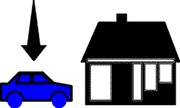
2) There is a new roof on the house.
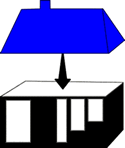
3) The house is in Tippecanoe county.
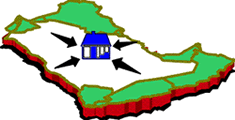
4) There are five rooms in the house, which has a lovely fireplace in the living room.


All of these sentences answer a question of the form, "Where is _______?" but each gives different information. Before going on, explain to yourself the spatial relations shown in each sentence.
1) locates a car in relation to a house, understood as a fixed point.
2) treats the house as a surface upon which another object, the roof, is placed.
3) locates the house within a geographical area.
4) treats the house as a three-dimensional structure that can be divided into smaller volumes, namely, rooms, inside one of which is an object, the fireplace.
Using "At"
At calls for further comment. Because it is the least specific of the prepositions in its spatial orientation, it has a great variety of uses. Here are some of them:
Location
5a) Tom is waiting for his sister at the bank.
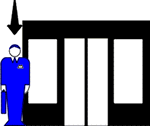
5b) Sue spent the whole afternoon at the fair.
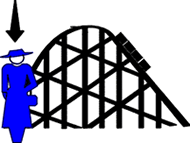
Destination
6a) We arrived at the house.

6b) The waiter was at our table immediately.
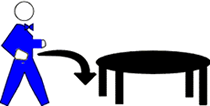
Direction
7a) The policeman leaped at the assailant.
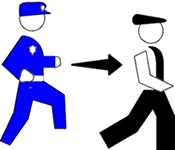
7b) The dog jumped at my face and really scared me.
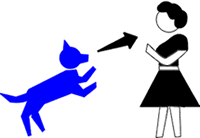
In 5a), the bank can be understood as a point defining Tom's location, much as in 1) above. It makes less sense to think of a fair as a point in 5b) since fairs are usually spread out over a fairly large area. Probably at is used in this case just because it is the least specific preposition; it defines Sue's location with respect to the fair rather than some other place.
In 6a), at exhibits its cause/effect relationship with to, which cannot be used here: arrival at a place is the result of going to it. For more on this relationship, see the handout Prepositions of Direction: To, (On)to, (In)to.
7a) and 7b) show that with certain verbs of motion at may be used with the same meaning as its directional counterpart to, that is, direction toward something.
Choosing Between "In" and "On"
Nouns denoting enclosed spaces, such as a field or a window, take both on and in. The prepositions have their normal meanings with these nouns: on is used when the space is considered as a surface, in when the space is presented as an area:
Three players are practicing on the field. (surface)
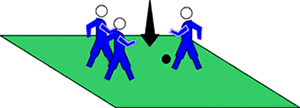
Three cows are grazing in the field. (area)
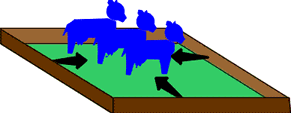
The frost made patterns on the window. (surface)
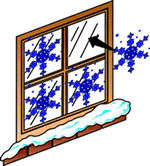
A face appeared in the window. (area)
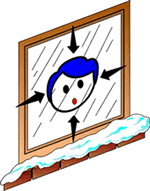
Notice that in implies that the field is enclosed, whereas on implies only that the following noun denotes a surface and not necessarily an enclosed area:
The sheep are grazing in the pasture. (enclosed by a fence)

The cattle are grazing on the open range. (not enclosed by a fence)
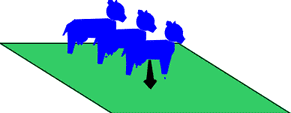
Three players are on the basketball court. (not enclosed)
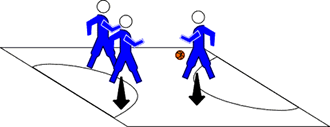
Two boxers are in the ring. (enclosed by ropes)
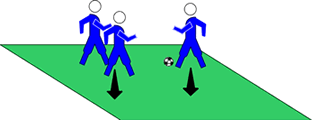
When the area has metaphorical instead of actual boundaries, such as when field means "academic discipline," in is used:
She is a leading researcher in the bioengineering field.
Several common uses of in and on occur with street. The first two follow the general pattern of in and on usage. The third is an idiom that must be learned as a unit.
a) The children are playing in the street.
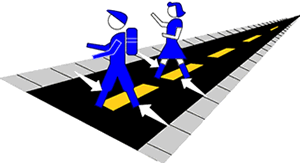
b) Our house is on Third Street.
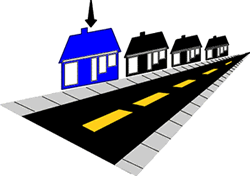
c) He declared bankruptcy last week, and now he's out on the street.
(This is an idiom meaning that he's poor.)
In a), the street is understood as an area enclosed by the sidewalks on either side. Compare b) with the discussion of sentence 3) in the first section. Here, on locates the house on either side of Third Street; it doesn't mean that the street is a surface on which the house sits. Because the street is understood as a line next to which the house is situated, on functions much like at in its normal use; in other words, it locates the house in relation to the street but does not specify the exact address. For that purpose, at is used because the address is like a particular point on the line. Compare: "Our house is at 323 Third Street." In c), out on the street is an idiom meaning "poor" or "destitute."
In and on are also used with means of transportation: in is used with a car, on with public or commercial means of transportation:
in the car
on the bus
on the plane
on the train
on the ship
Some speakers of English make a further distinction for public modes of transportation, using in when the carrier is stationary and on when it is in motion.
My wife stayed in/on the bus while I got out at the rest stop.
The passengers sat in/on the plane awaiting takeoff.
Basic Grammer and Usage 8th Edition Chapter 1 & 2
Source: https://owl.purdue.edu/owl/general_writing/grammar/prepositions/prepositions_of_location_at_in_on.html